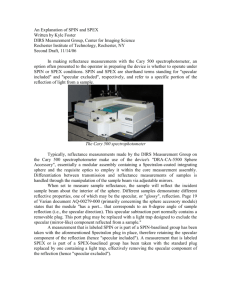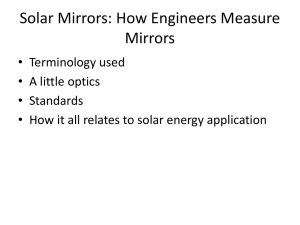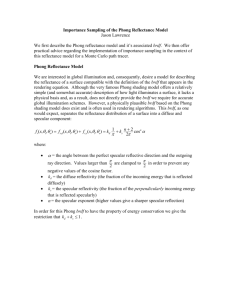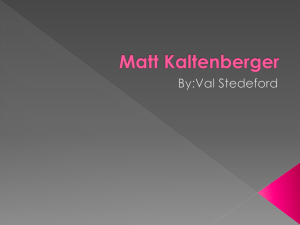Reflectance changes i
advertisement
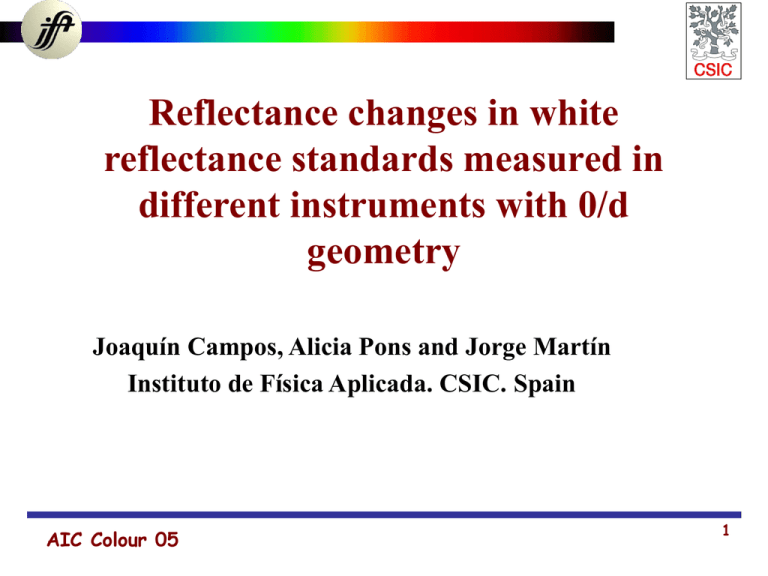
Reflectance changes in white reflectance standards measured in different instruments with 0/d geometry Joaquín Campos, Alicia Pons and Jorge Martín Instituto de Física Aplicada. CSIC. Spain AIC Colour 05 1 Outline Introduction Instruments used Measurements Results Summary AIC Colour 05 2 Introduction • Spectrophotometric errors in measurement of reflectance 0/d widely studied. • Calibration standard (white standard) is assumed to be constant. • 0/d reflectance measurement are done with an integrating sphere. Sphere error corrections • Procedure developed at NPL: correction factors for the correct inclusion and exclusion of the specular component of reflectance. AIC Colour 05 3 Specular beam exclusion error (gloss trap error) A gloss trap which does not completely eliminate light specularly reflected can lead to an error that depends on the specific instrument. Measuring the reflectance of a mirror in the specular excluded geometry m reading with the mirror 4 m ( ) K 2 ( ) Rt ( ) M ( ) t ( ) t reading with the standard M mirror’s reflectance Rt standard’s reflectance AIC Colour 05 4 Specular beam weighting error In many integrating spheres, light specularly reflected may not be evaluated with the same efficiency as light diffusely reflected. An error will be present in total reflectance measurements. Measuring the reflectance of a mirror in the specular included geometry Rt ( ) m ( ) K 3 ( ) 4 1 M ( ) t ( ) AIC Colour 05 m reading with the mirror t reading with the standard M mirror’s reflectance Rt standard’s reflectance 5 To test the goodness of this procedure by measuring the reflectance of several types of white reflectance standards in different high quality spectrophotometers and compare the values obtained for every standard with every instrument, once the corrections have been applied. AIC Colour 05 6 Measurements Samples – – – – – Glossy white ceramic tiles Matt white ceramic tiles Spectralon type white standards BCR matt white standards BCR glossy white standards AIC Colour 05 7 Measurements Spectrophotometers PE Lambda 900 PE Lambda 9 – Internal diameter: 150 mm – Paint covering: Spectralon – Incidence angle: 7º for exclusion and inclusion – Internal diameter: 60 mm – Paint covering: Spectralon – Incidence angle: 7º for exclusion and inclusion AIC Colour 05 Cary 17 – Internal diameter: 60 mm – Paint covering: barium sulphate – Incidence angle: 0º when excluding and 7,5º when including 8 Specular beam exclusion error 0,20 Lambda 900 Lambda 9 Cary 17 Correction Factor K2 0,18 0,16 0,14 0,12 0,10 0,08 0,06 0,04 0,02 0,00 350 400 450 500 550 600 650 700 750 800 Wavelength (nm) AIC Colour 05 9 Specular beam weighting error Lambda 900 Lambda 9 Cary 17 0,8 Correction Factor K3 0,6 0,4 0,2 0,0 350 -0,2 400 450 500 550 600 650 700 750 800 -0,4 -0,6 AIC Colour 05 Wavelength (nm) 10 Measurements • Reflectance of every sample was measured (including and excluding the specular component) in the three instruments taking one of the matt standards as a reference, the same for all instruments AIC Colour 05 11 Measurements Corrected reflectance: R ( ) ( ) s ( ) Rt ( ) K i ( ) s t ( ) t ( ) s t Rt Ki instrument’s reading when sample is measured instrument’s reading when reference is measured reference standard’s reflectance (in practice not used) correction coefficient for exclusion (i=2) or inclusion (i=3) of specular component and coefficients related to sample and standard, 1 for glossy specimens and zero for matt ones. AIC Colour 05 12 Differences from the mean (%) Lambda 900 Lambda 9 Cary 17 1,00 0,75 0,50 0,25 0,00 400 500 600 700 800 -0,25 -0,50 -0,75 -1,00 Wavelength (nm) (glossy to matt) Differences from the mean (%) Differences from the mean (%) Specular included geometry Lambda 900 Lambda 9 Cary 17 1,00 0,75 Lambda 900 Lambda 9 Cary 17 1,00 0,75 0,50 0,25 0,00 400 500 600 700 800 -0,25 -0,50 -0,75 -1,00 Wavelength (nm) (matt to matt) • Differences < uncertainties 0,50 0,25 0,00 400 500 600 700 -0,25 -0,50 800 • Procedure correct specular beam weighting error -0,75 -1,00 Wavelength (nm) (glossy to glossy) AIC Colour 05 13 Differences from the mean (%) Lambda 900 Lambda 9 Cary 17 1,00 0,75 0,50 0,25 0,00 400 500 600 700 800 -0,25 -0,50 -0,75 -1,00 Wavelength (nm) (glossy to matt) Lambda 900 Lambda 9 Cary 17 1,00 0,75 0,50 0,00 400 500 600 700 -0,50 -0,75 -1,00 Wavelength (nm) (glossy to glossy) AIC Colour 05 Lambda 900 Lambda 9 Cary 17 1,00 0,75 0,50 0,25 0,00 400 500 600 700 800 -0,25 -0,50 -0,75 -1,00 Wavelength (nm) (matt to matt) • Differences > uncertainties (shorter wavelengths) 0,25 -0,25 Differences from the mean (%) Differences from the mean (%) Specular excluded geometry 800 • Angles of incidence and sphere diameters • Different, function of , angular distribution of reflectance 14 Summary • In specular included geometry, the adopted procedure allows to correct for the possible specular beam weighting error. • In specular excluded geometry, significant differences can be observed not only for different angles of incidence, but also for different spehere diameters. • In the example glossy to matt, the differences seem to indicate that the adopted procedure does not correct adequately for the possible specular beam exclusion error; but this assumption cannot be used to explain the differences in the matt to matt example. • A more exhaustive research is necessary. BRDF. AIC Colour 05 15
